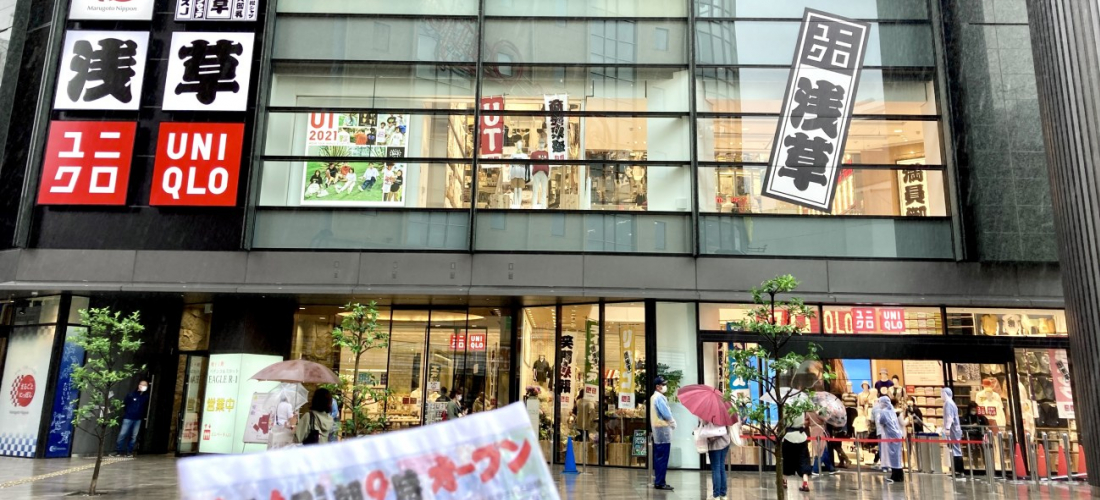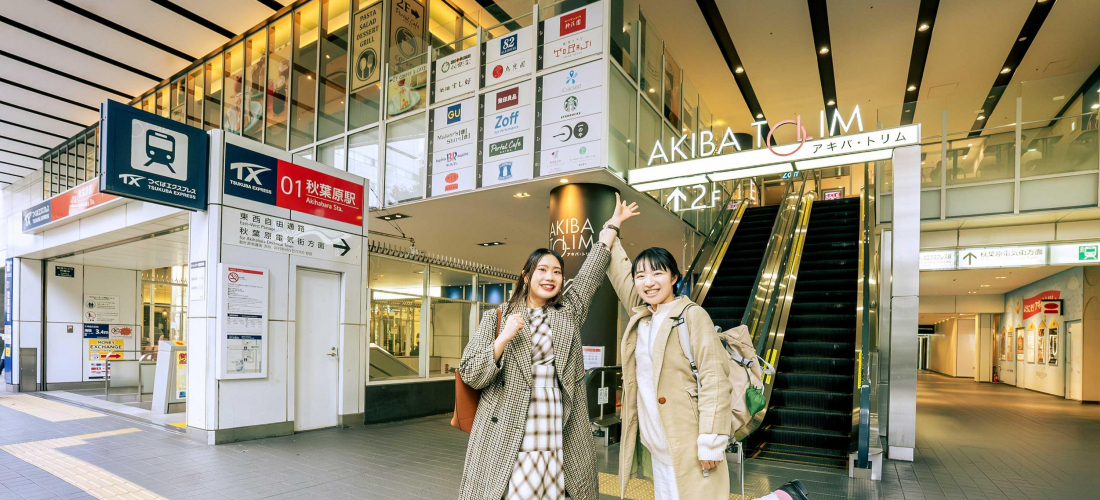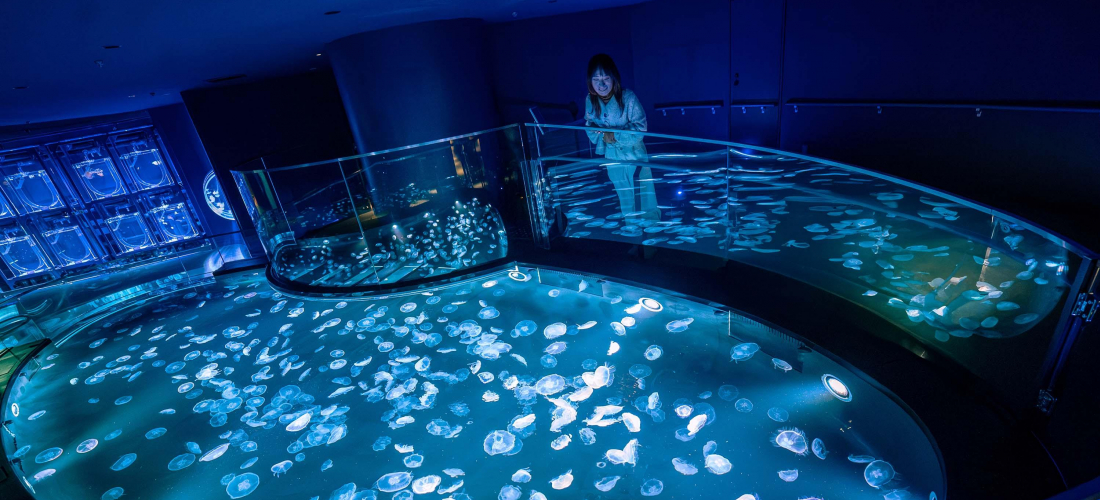
Japanese Baby Shopping Recommendations From Our Japanese Mom Friends • Find the Best Baby Products in Japan With Our Akachan Honpo Shopping List!
This article contains sponsored content.
Planning a trip to Japan? Make it a shopping opportunity! Japan is known for producing clever products with cute designs (exactly what any new parent is looking for), and Akachan Honpo sells a wide selection of Japanese baby products, making it the go-to spot for locals shopping for their own kids in Japan. So the Japankuru team, on a mission to find the best baby products for parents visiting Japan (or anyone looking for a nice Japanese baby gift), consulted our friends with kids living in Japan to find their favorite items for their own children!
CONTENTS
*Product stock may vary. Prices are accurate to the time of writing and may be subject to change.
Great Deals on Baby Products in Japan
▶︎ Take Advantage of the Weak Yen and Tax-Free Discounts!

Everyone likes to shop for different souvenirs from Japan, from tasty snacks and cosmetics at the drug store to flashy anime merchandise. But experienced travelers, especially those with kids, will tell you that Japan is the place to go for amazing baby and kids shopping! The easiest place to find all of the must-have Japanese baby products together in one room is Akachan Honpo, a specialty store with locations all over Japan and shelves lined with everything a baby needs (plus plenty of maternity and kids’ products too). Whether you want to find the best products for your own children, or you’re hoping to find the perfect gift for a friend or family member with kids, Akachan Honpo is a convenient one-stop shop for Japanese baby goods. With the weak Japanese yen, Japan’s easy tax-free shopping options, and so many products only found in Japan, there’s never been a better time to shop.
To make it easier for busy parents visiting Japan, the Japankuru team had a chat with some of our friends who are working parents in Tokyo – especially one mom with a three-year-old son. (She’s spent a lot of time over the past few years shopping for a baby!) To see what they were talking about, we all headed over to the Akachan Honpo next to Kinshicho Station, and put together a list of popular products really used by parents in Japan. The items range from feeding bottles and baby formula (easy to bring back home) to strollers and slings (especially good for using while vacationing in Japan), so let’s take a look at our list of recommended Japanese baby products!
Akachan Honpo Arcakit Kinshicho Shop (アカチャンホンポ アルカキット錦糸町店)
Arcakit Kinshicho 5F, 2-2-1 Kinshi, Sumida-ku, Tokyo
Hours: 10:00 – 21:00
Directions: 1 min from the north exit of JR Kinshicho Station, then take the escalators up to the 5th floor
Official Website (jp)
For Feeding Time: Bottles & Formula
Recommendation ①
Meiji Hohoemi Formula
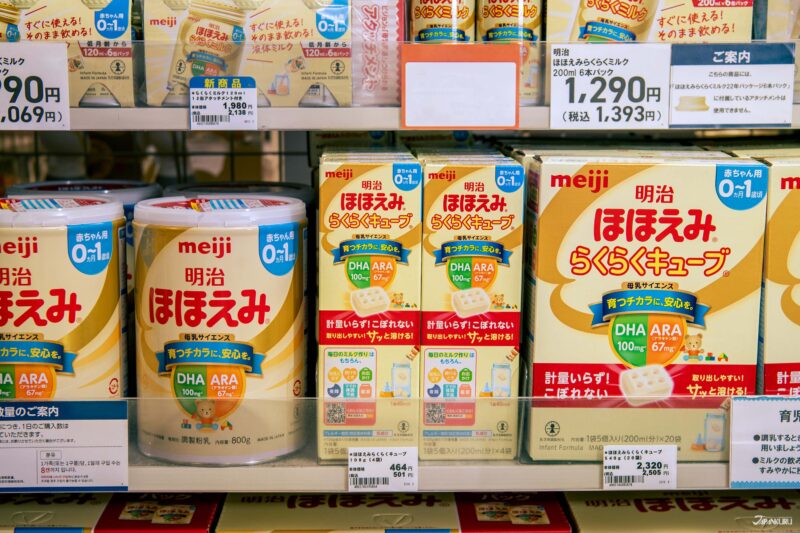
The Meiji brand name is known all over Japan, and their infant formula products have been on the market for more than 100 years. Their popular Meiji Hohoemi Formula product line, for infants up to around a year old, has been the focus of some intense research and development. Meiji used data collected from the breast milk of over 6,000 mothers across Japan, while also studying the development of hundreds of thousands of babies, in order to make the formula as close to real breast milk as possible. The result is a product widely used in Japanese households.
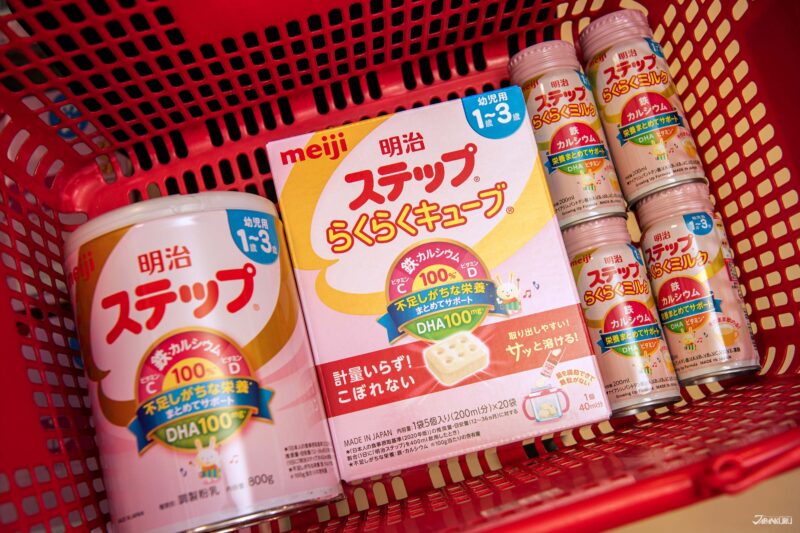
For children around one to three years old, Meiji also offers their Meiji Step nutritional support formula, a follow-up formula that helps to provide vital nutrition for growing babies and toddlers. Paired with meals and solid foods, it offers all the nutrients babies need to grow, like iron, vitamin C, vitamin D, and DHA.
Both the Hohoemi and Step product lines consist of formula in a few different forms, including standard cans of powder, but their “RakuRaku Cubes” are especially popular. These pressed blocks of formula powder are lightweight, portable, and convenient to use on the go – just bring a pack of RakuRaku Cube formula, some hot water, and a baby bottle, and you’ve got formula ready when and where you need it. (If you’re going somewhere with hot water available, it’s even easier!) Unlike traditional formula powder, these cubes won’t get messy when you’re out and about, so it’s easy for anybody to help feed the baby.
It’s worth mentioning that the cubes also come wrapped in small pouches, just a few blocks each, so before the packaging is opened they have a relatively long shelf life. Unlike canned formula (which needs to be consumed within a month), an unopened package of RakuRaku Cubes can safely be kept for quite a while, so it’s great to have around in case of emergencies!
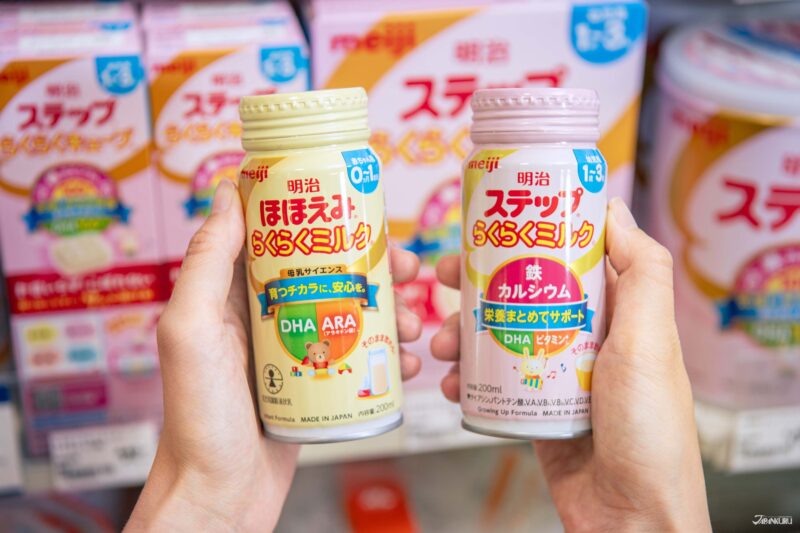
For the ultimate in convenience, Meiji also offers both of their formulas in liquid form! The RakuRaku Cubes are already pretty easy to use, but these cans don’t even require any hot water – just pour the formula into a baby bottle and it’s ready to go.
Recommendation ②
Pigeon’s Feeding Bottles, Just Like the Real Thing
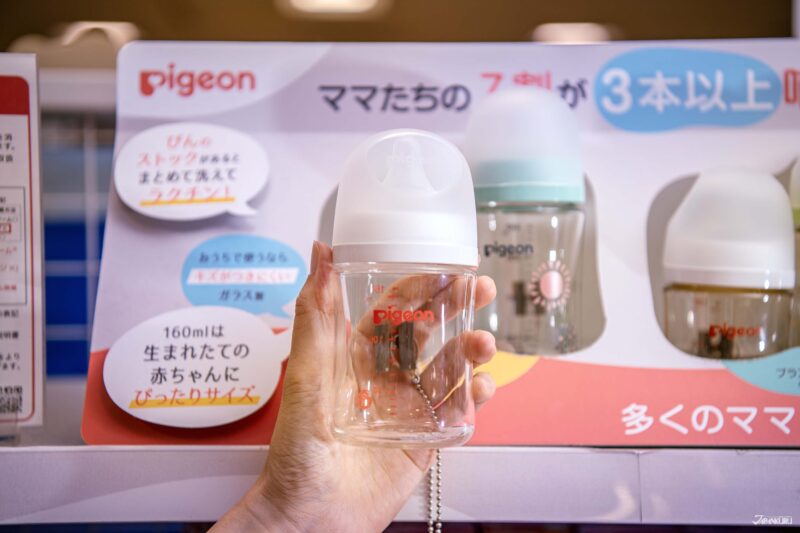
Japan’s parents (and infants) harbor a deep appreciation for Pigeon’s feeding bottles, which are made to feel as much like real breastfeeding as possible, placing them squarely on this list. Designed based on research examining the process of real breastfeeding, the nipples on these bottles are shaped to resemble real nipples so that babies won’t even notice the difference – they can just keep on drinking as they would naturally. The bottles themselves are made of heat-resistant glass and come in three sizes, but the 160ml is especially popular because it’s just the right size for newborns, who can only drink so much!
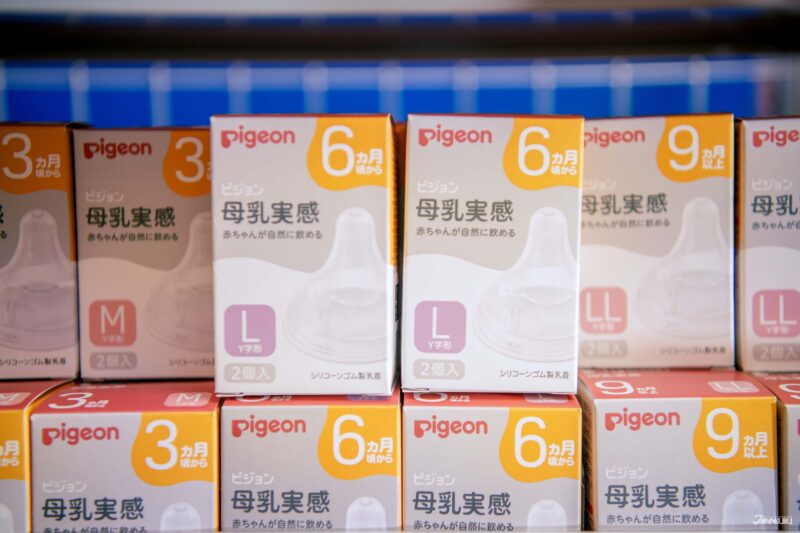
The nipples also come in a series of six sizes to adjust with your baby as they grow, from SS (for newborns) to 3L (for about 15 months and up). Most of the sizes (aside from SS) come two to a box, convenient for swapping out when necessary.
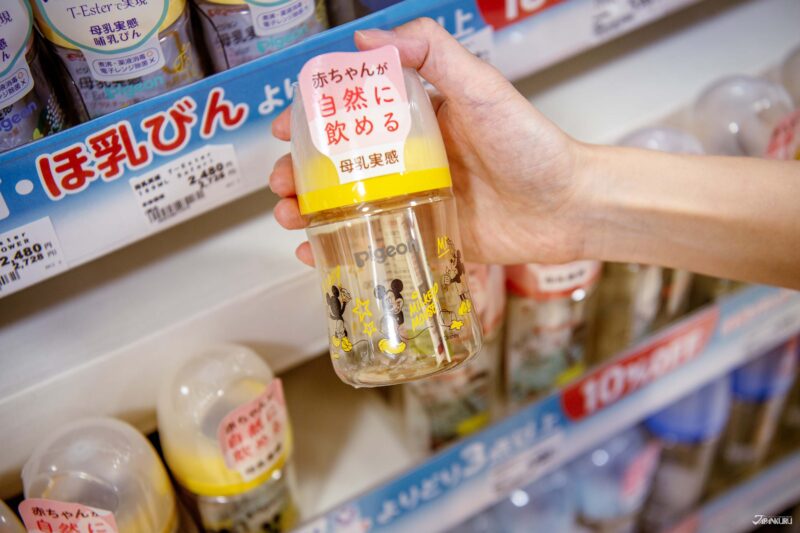
Of course, the practicality of Pigeon’s bottles isn’t the only reason they’re popular. They also come in a variety of cute patterns, including fun ones featuring Disney characters!
Recommendation ③
Dr. Betta Artisan Handmade Bottles, to Keep Baby’s Stomach Happy

Dr. Betta’s glass feeding bottles are handmade by Japanese craftsmen, and carefully shaped to help babies bottle-feed in the same position they would breastfeed. By maintaining the same posture as regular breastfeeding, these bottles help to prevent many of the problems that often accompany bottle-feeding, like swallowing excess air, spit up, and even milk flowing into the ear canal.
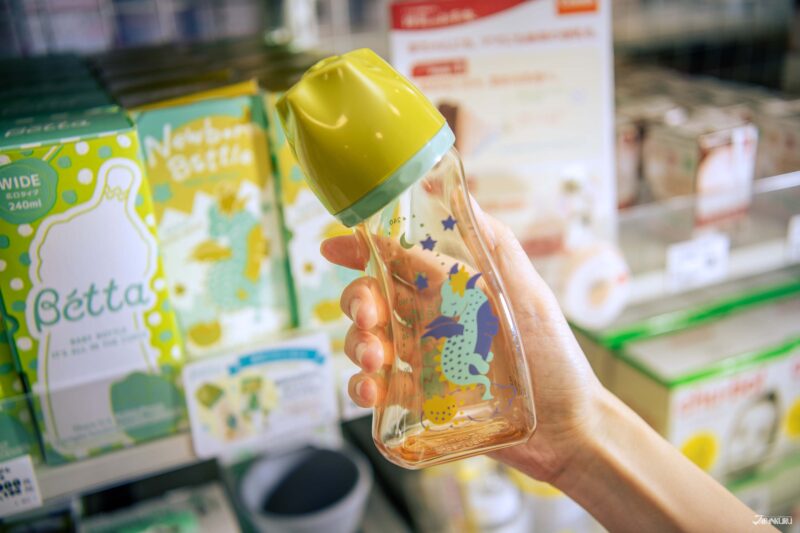
Dr. Betta’s handmade bottles have won Japan’s Good Design and Kids’ Design Awards with their sleek, stylish shape, and they come decorated in plenty of cute designs too. For a baby bottle, they’re relatively expensive, but that’s exactly why it makes sense to buy one in Japan. The cute bottle shown above features their new 2024 Year of the Dragon design!
For Bath and Body Care: Soap & Skin Products
Recommendation ④
Skina Babe Mild Moisturizing Baby Wash
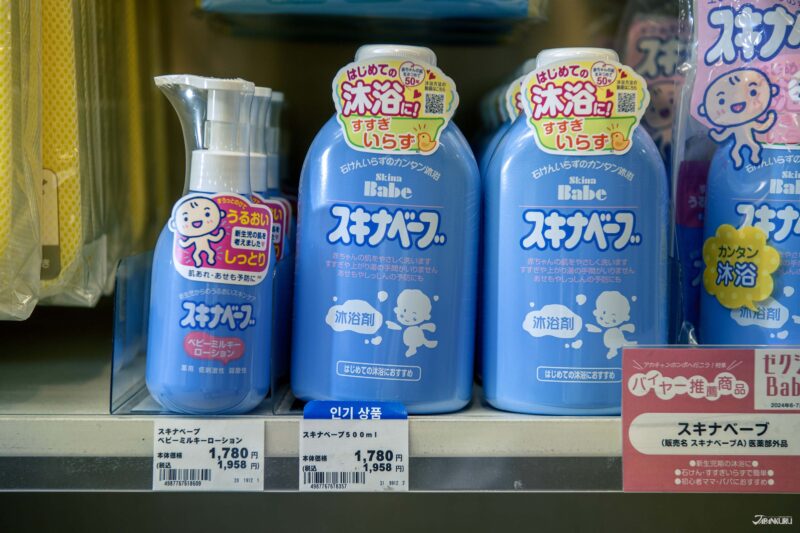
Developed with new parents in mind, this gentle no-rinse baby body wash can be used on newborn infants as early as their very first bath. Dissolve some in a baby bath, lay your baby gently in the water, and you can use a soft cloth to gently scrub them from head to toe (aside from the face, although hair is fine). Since the formula is soap-free, you don’t have to worry about baby slipping around, and it doesn’t need to be rinsed off either, making it easy for anyone taking care of the baby to have a fuss-free bath time. The ingredients do include mild moisturizers, however, which also help stave off rashes.
Recommendation ⑤
Mama & Kids Moisturizing Lotion & Baby Protect Veil
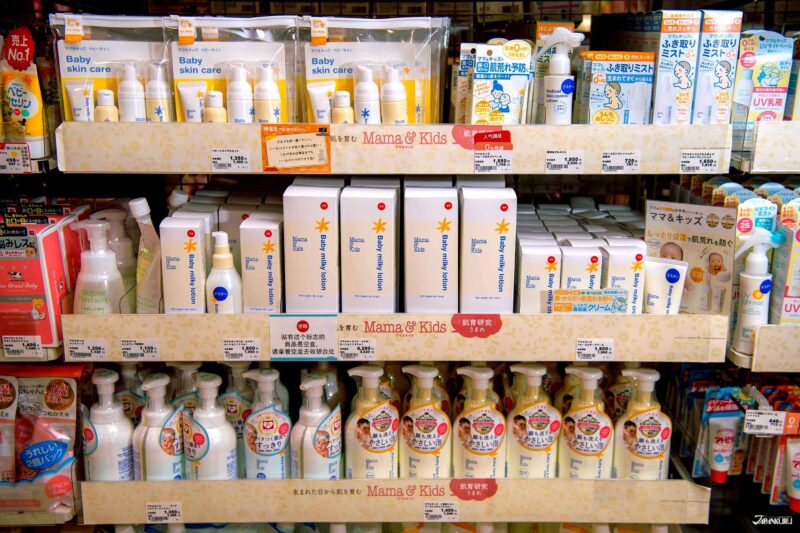
Mama & Kids’ moisturizing products are big in Japan, including the Baby Milky Lotion, which contains eight moisturizing amino acids also found in amniotic fluid, and another eight ingredients that imitate the vernix – the coating found on a newborn’s skin. Not only do these protective moisturizing ingredients work great on your baby’s skin, but parents often swear by it, using it on themselves as well.

The Mama & Kids Baby Protect Veil is another moisturizing product made to prevent chapped skin around your baby’s mouth, even through the drips and dribbles of mealtime. For parents who find themselves wiping away drool so often that it irritates the skin around their baby’s mouth, this cream can be applied around the mouth before feeding starts to prevent irritation, and again after the mouth has been wiped clean for an extra protective layer.
Recommendation ⑥
Pigeon Peach Leaf Medicated Lotion
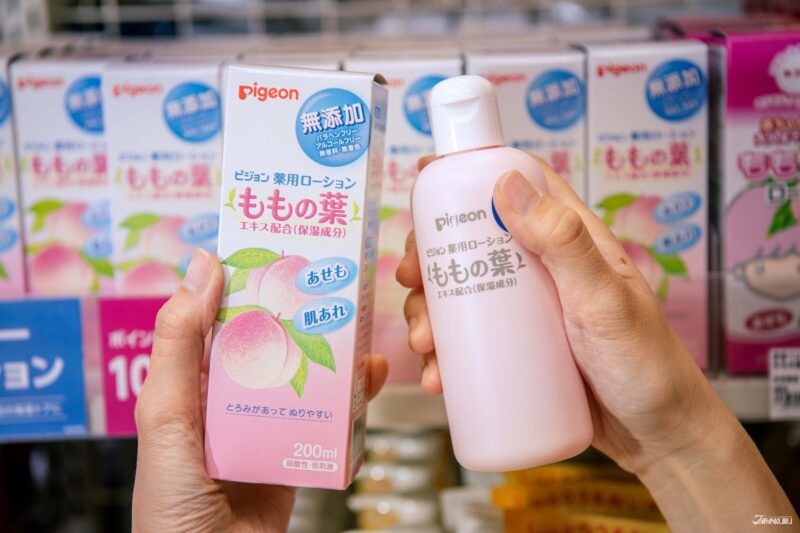
If those Mama & Kids’ moisturizers are a little out of your budget, you might want to consider the more affordable option of Pigeon’s Peach Leaf Medicated Lotion. The lotion is formulated with peach leaf and aloe vera extracts for a product that is mildly acidic and gentle on the skin, and since it has no added dyes, fragrances, or alcohol, it can even be used on newborns. The moisturizing lotion slides comfortably across the skin, and since it’s not terribly expensive, it’s definitely worth a try!
For Trips Out of the House: Strollers & Carriers
Recommendation ⑦
Cybex’s Lightweight Strollers: Orfeo, Libelle, & a Special Akachan Honpo Stroller
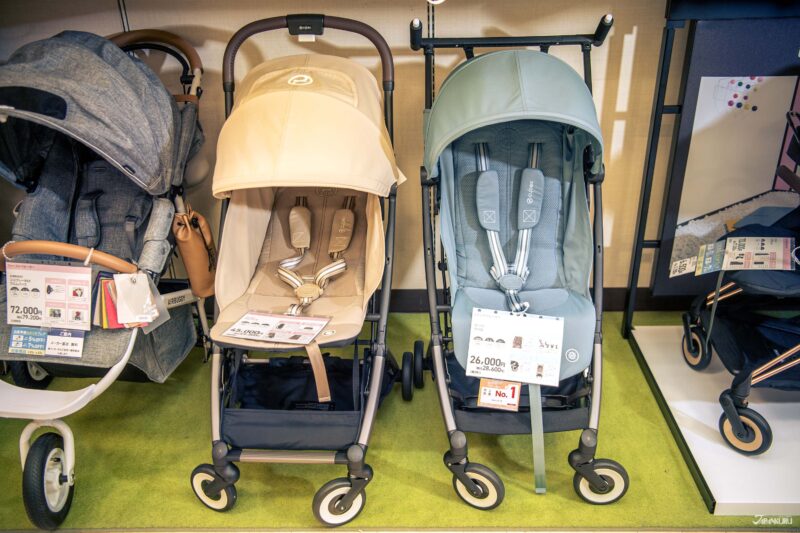
The lightweight travel strollers (AKA prams or pushchairs) developed by the German brand Cybex are hugely popular in Japan, and their two best-selling models are the Orfeo and the Libelle. The practical and compactable Orfeo is made for babies as small as a month old and up to 22 kg, and the 6.1 kg stroller (minus the canopy) can be stowed away with just one hand, leaving it standing compact but stable. Since it’s so easy to store, the Orfeo is a convenient option for travelers planning to travel by plane, but the compact stroller is still equipped with a safety harness just like the ones used in car seats. The special “One-Pull Harness” can even be safely adjusted with just one hand, fitting snug to your child with just a tug, minimizing the stress of outings with the baby. (You can also get a limited-edition Japan-only sun canopy with two mesh windows that not only help with airflow, but also make it easy to check in on your kid under the canopy.)
For older babies who can sit up, six months to four years old (or up to 22 kg), the Libelle is another lightweight travel stroller made to be convenient on the go. Weighing in at 6.2 kg (without a canopy), the Libelle can’t quite be stored away one-handed like the Orfeo, but it’s still a breeze to stow, and the compact size also makes it easy to bring on a plane!

Another option is the conveniently portable Melio Carbon stroller made in collaboration with Akachan Honpo, only 5.9 kg thanks to the ultra-lightweight carbon fiber construction. The newborn inlay is made of absorbent quick-drying material, and the special design includes unique colors, embroidery, and rubber decorations.
Recommendation ⑧
The Ergobaby OMNI Breeze, a Multi-Function Carrier Made for Long-Term Use

Even in Japan, the American brand Ergobaby is known for their baby slings and carriers, and the OMNI Breeze series is particularly popular due to the gentle, breathable SoftFlex™ patented mesh material, combined with an ergonomic load-bearing design. The practical carrier can be used in four different ways (inward-facing front carry, outward-facing front carry, back carry, hip carry) for babies weighing anywhere between 3.2 and 20.4 kg. (The weight limit varies depending on the position, so please check the manual before use!)
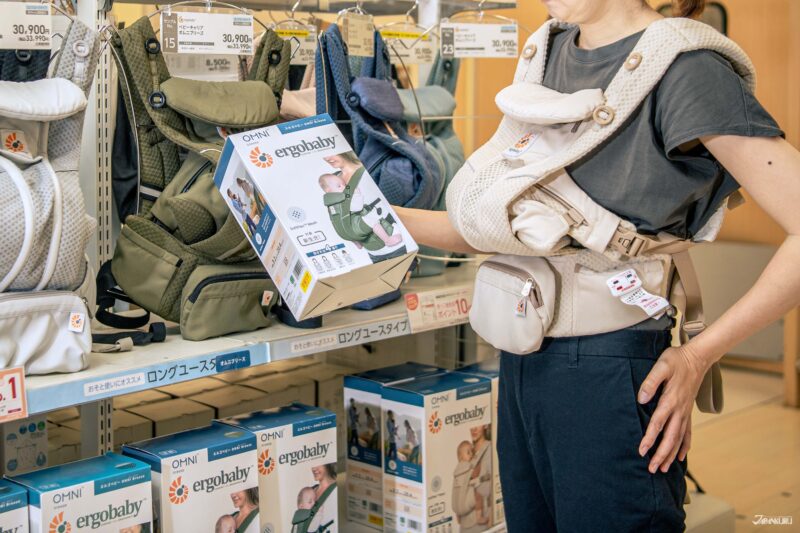
This baby carrier is easy to use without any help, and it comes in quite a few colors and styles, so it’s a bit hit among the parents of Japan!
For Play Time: Toys and More
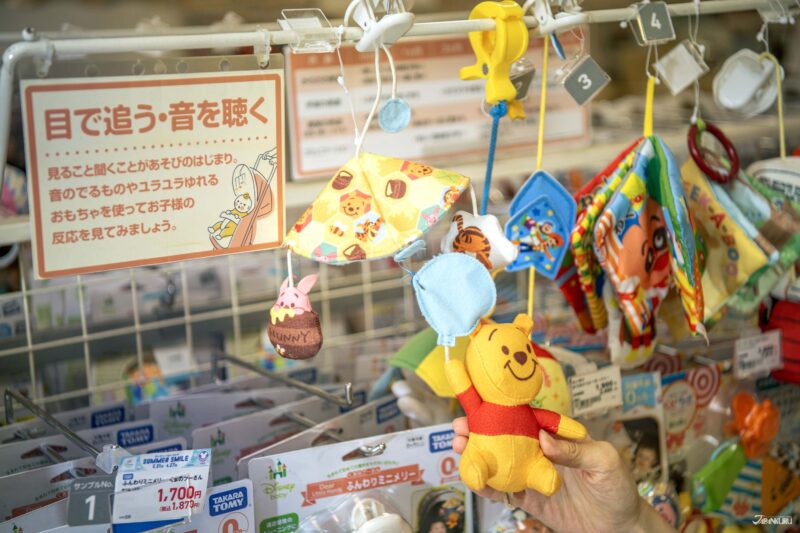
One of the great pleasures of shopping in Japan is finding all the many bits and bobs decorated with cute characters, and of course that holds true with maternity and kids’ products too! Both Japanese and foreign characters can be found on products of all kinds, like the cute Disney Winnie the Pooh seen in this popular dangly mini mobile (above) for strollers. Babies can grab onto the little stuffed toys, attached to customizable hanging strings, and each little figure is detachable as well. Good for playtime, and convenient for hand-washing.
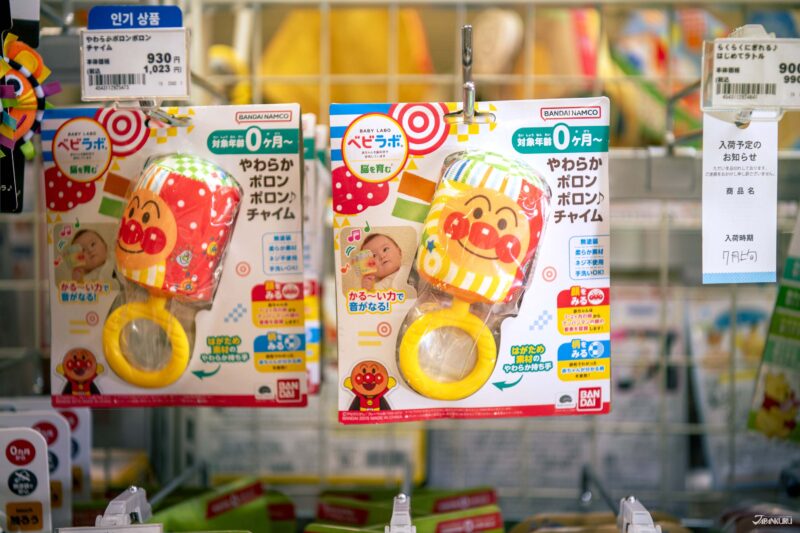
Another big character is Anpanman, a star of Japanese kids’ cartoons whose head is made out of a red bean bun! Anpanman’s smiling face can be found all over Akachan Honpo, but two of the shop’s best-selling baby toys are Anpanman baby rattles. One is a colorful cloth rattle that makes a gentle noise, with a handle as thick as a pinky finger, easy for little hands to hold. The soft fabric is washable and won’t hurt if it hits a baby’s face, so even infants under a year can enjoy this one.
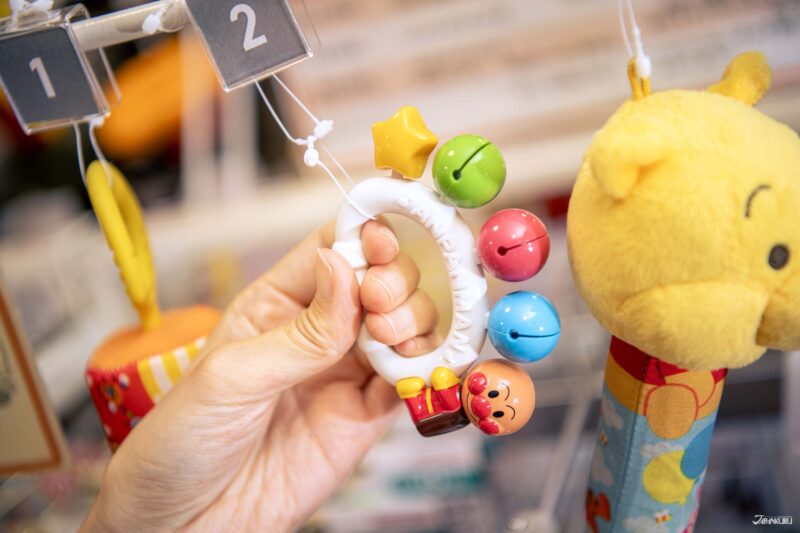
The other popular Anpanman baby rattle is made of plastic, so it’s good for babies 3 months and older, and the outer UV coating makes it safe for babies to put in their mouths. The little star at the top of the rattle can be turned, helping little ones to learn to use their hands, and promoting development.
The list of popular items goes on, but if you’re hoping to head to Akachan Honpo to shop for baby, kids, and maternity products in Japan, this location next to Kinshicho Station is a great option. Not only does the shop have a huge selection, but they’re ready to cater to foreign shoppers, whether you know exactly what you want when you get there, or you just want to see what fun items Japan has to offer.
Tax-Free Shopping & Easy Payment Methods
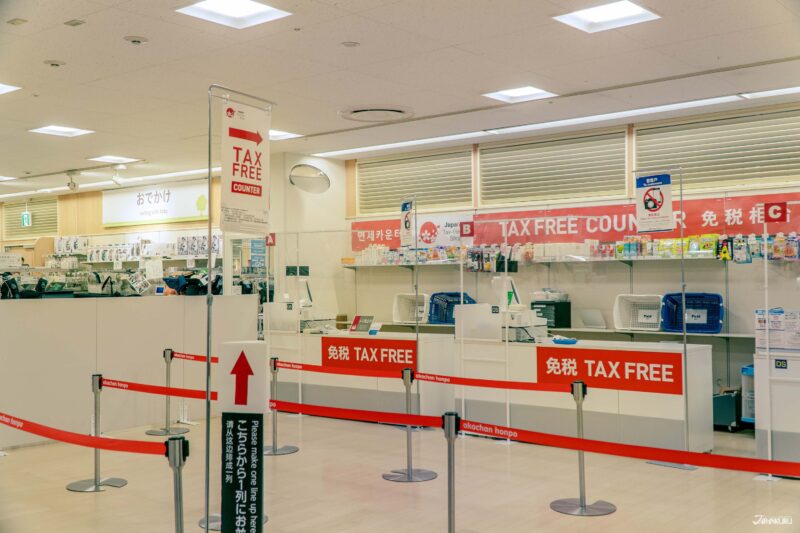
After checking out all the favorites from our working mom and dad friends, it’s time to check out! Foreign shoppers will be pleased to hear that Akachan Honpo offers tax-free shopping on eligible purchases of 5,000 to 500,000 yen (before tax), which makes it all an especially good deal. (Certain products may not be eligible, so you can check Akachan Honpo’s official Tax-Free Guide for details.) Aside from the Kinshicho store with its large tax-free counter, many of Akachan Honpo’s other locations also offer the service – check the shop search on the official website to find them.
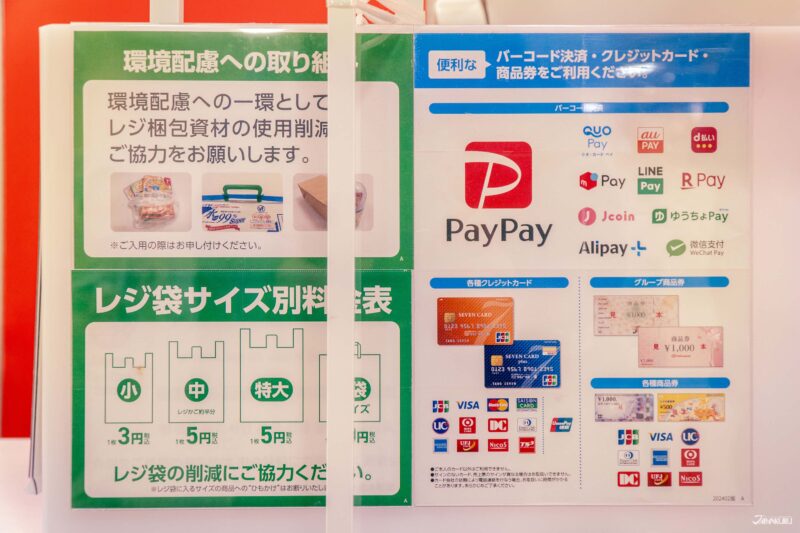
Cash is still a popular payment method in Japan, but Akachan Honpo also offers a pretty wide variety of payment methods to cater to customers coming from all over the world, including credit cards, certain payment apps, gift cards, and more. (The exact options vary from store to store.) Some of the more international app options include Alipay and WeChat Pay (common in China), GCash (the Philippines), Kakao Pay and TossPayment (Korea), Touch ‘n Go eWallet (Malaysia), and True Money (Thailand).

Providing the best for your baby, or just finding the perfect present for a new addition to a friend’s family, can be difficult with so many options on the market. So out of all the product recommendations we found this time, which are your must-buys? Whether you’re stocking up on Japanese favorites for your own kids or shopping for friends and family, now’s a great time to go shopping in Japan, so take advantage of your Japanese vacation or your next business trip to Tokyo and check out an Akachan Honpo!
For more info and updates from Japan, check Japankuru for new articles, and don’t forget to follow us on X (Twitter), Instagram, and Facebook!





 >> Find out more at Japankuru.com! (link in bio)
#
>> Find out more at Japankuru.com! (link in bio)
#





 The Robot Restaurant is gone, but the Samurai Restaurant is here to take its place. Check it out, and don't forget your coupon!
The Robot Restaurant is gone, but the Samurai Restaurant is here to take its place. Check it out, and don't forget your coupon!
 신주쿠의 명소 로봇 레스토랑이 사무라이 레스토랑으로 부활! 절찬 쿠폰 발급중
신주쿠의 명소 로봇 레스토랑이 사무라이 레스토랑으로 부활! 절찬 쿠폰 발급중
 18歲以上才能入場的歌舞秀,和你想的不一樣!拿好優惠券去看看~
#tokyo #shinjuku #samurairestaurant #robotrestaurant #tokyotrip #도쿄여행 #신주쿠 #사무라이레스토랑 #이색체험 #할인이벤트 #歌舞伎町 #東京景點 #武士餐廳 #日本表演 #日本文化體驗 #japankuru #japantrip #japantravel #japanlovers #japan_of_insta
18歲以上才能入場的歌舞秀,和你想的不一樣!拿好優惠券去看看~
#tokyo #shinjuku #samurairestaurant #robotrestaurant #tokyotrip #도쿄여행 #신주쿠 #사무라이레스토랑 #이색체험 #할인이벤트 #歌舞伎町 #東京景點 #武士餐廳 #日本表演 #日本文化體驗 #japankuru #japantrip #japantravel #japanlovers #japan_of_insta
 코지마 x 빅 카메라 쿠폰으로 일본 가전 제품 쇼핑하기
#pr #japankuru #japanshopping #kojima #biccamera #japaneseskincare #yaman #dji #osmopocket3 #skincaredevice #日本購物 #美容儀 #相機 #雅萌 #日本家電 #일본여행 #면세 #여행꿀팁 #일본쇼핑리스트 #쿠폰 #일본쇼핑 #일본브랜드 #할인 #코지마 #빅카메라 #japankurucoupon
코지마 x 빅 카메라 쿠폰으로 일본 가전 제품 쇼핑하기
#pr #japankuru #japanshopping #kojima #biccamera #japaneseskincare #yaman #dji #osmopocket3 #skincaredevice #日本購物 #美容儀 #相機 #雅萌 #日本家電 #일본여행 #면세 #여행꿀팁 #일본쇼핑리스트 #쿠폰 #일본쇼핑 #일본브랜드 #할인 #코지마 #빅카메라 #japankurucoupon









































